KEY FINDINGS
Scroll or select a topic:
Here we compare the Index with other factors (secondary metrics), such as health spending, access to health care, and immunisation uptake. Through analysis, we can identify what issues drive good and poor performance and actions countries must take to improve their global ranking.
Key findings from the Index:
- The countries ranked in the Index’s top ten are: Switzerland, Iceland, Norway, Sweden, Singapore, Australia, Luxembourg, Netherlands, Denmark and Ireland.
- Of the top 20, only a third are non-European. These include Singapore (ranked 5th), Australia (ranked 6th), Canada and New Zealand (jointly ranked 11th), Israel (ranked 13th), and Japan (ranked 17th).
There are significant health and wealth inequalities between countries at the top and bottom of the Index:
- On the life span metric, there is a 24-year gap between the top 10 and bottom 10 countries.
- On the health span metric, there is a 21-year gap between the top and bottom 10 countries.
- On the wealth span metric, there is a 23- year gap between the top and bottom 10 countries.
This page will be regularly updated with new findings.
Demographic analysis
Percentage of the global population by country grouping
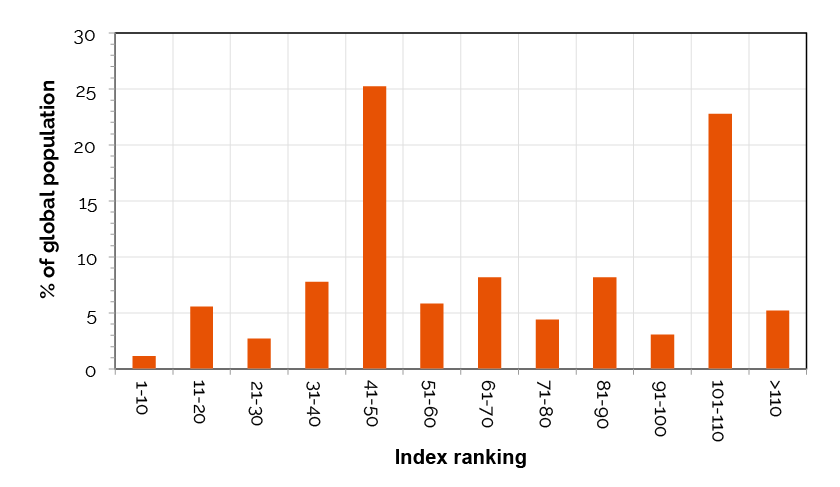
Cumulative percentage of global population by country grouping and rank

- With an average population of only 8.4 million, the top 10 countries on the Index account for only 1.1% of the global population, while the top 50 account for just over a quarter.
- This demonstrates significant inequality across the countries in the Index, whereby a relatively small proportion of the global population is best adapted to longer, healthier lives.
- This is particularly evident in the second graph showing the cumulative percentage of the global population by country grouping.
- Countries ranked from 41-50 (which include China) have the largest average populations with 186.7 million. Countries ranked from 101-110 (which include India) have the second largest average populations with 168.4 million.
Incentivising spending on prevention and immunisation
Countries that spend a higher proportion of their health budgets on prevention perform better on the Index
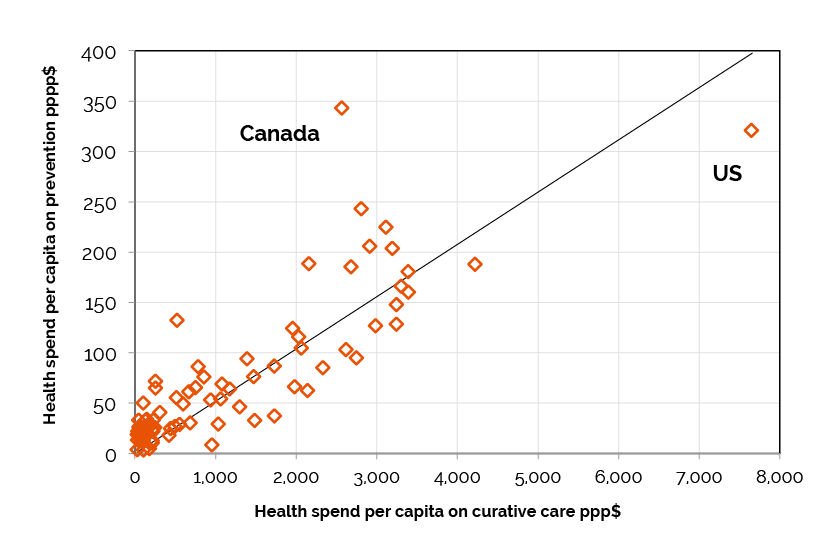
- Canada and the United States are outliers, with Canada spending relatively more on preventative healthcare than curative healthcare.
- In contrast, the US spends much more on healthcare than any other country in the Index but far more of it goes on curative care than on prevention.
- Canada spends approximately 6% of its health budget on prevention. As a result it has seen an increase in life expectancy from 79.1 to 82.2 years between 2000 and 2019. This compares with a smaller increase in US life expectancy from 76.7 years to 78.5 years over the same period.
Countries that spend more on preventative healthcare and immunisation perform better on the Index
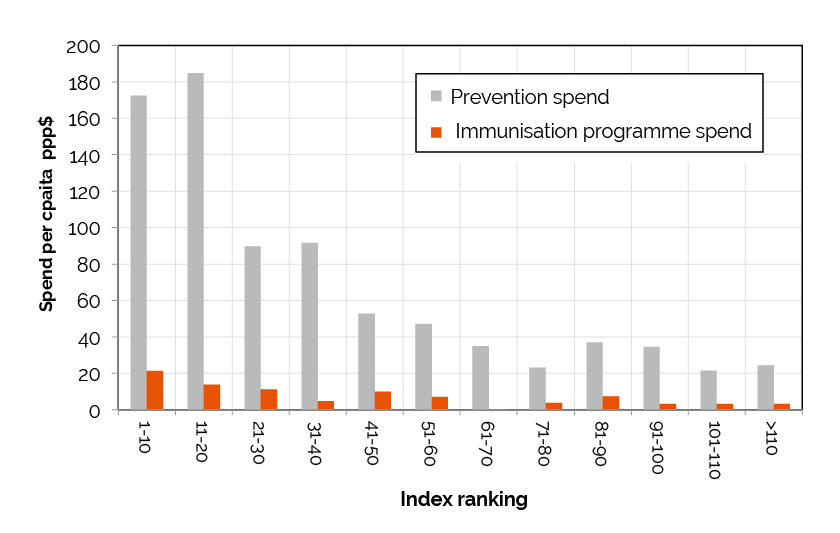
- Higher ranked countries spend significantly more on prevention than lower ranked countries.
- While higher ranked countries still spend more on immunisation than lower ranked countries, comparatively, immunisation programmes make up a very small proportion of overall prevention spend.
- For instance, for countries ranked 1-10 on the Index, per capita immunisation spend is only $21.30 compared with $174.48 for prevention. For those ranked 11-20, it is $13.91 and $184.85 respectively.
There is a noticeable difference between adult flu vaccination uptake between Western and Eastern Europe

- The chart shows that countries in Central and Eastern Europe, including former East bloc countries, have considerably lower rates of vaccination than Western European countries and effectively form a distinct group.
- The top vaccinated country of those included is Denmark (rank 9 on the Index) with 75% and the bottom vaccinated country with only 5.8% is Bulgaria (rank 56).
- Other countries in Western Europe include: Belgium, Finland, France, and the UK, all of which have high adult flu vaccine uptake.
- Other Eastern Europe countries with low uptake include: Hungary, Poland and Turkey.
Notes
Data for flu vaccination against influenza in the population aged 65 and over using latest data for each of the 31 European countries versus the Global Index up to 2020.
Western and Eastern European countries have been predominantly grouped based on geographical location, with Central European countries grouped with Eastern Europe. Greece is an outlier, where due to political reasons, has been grouped with Western Europe.
Countries that spend more on immunisation gain more years in life expectancy and perform better on the Index
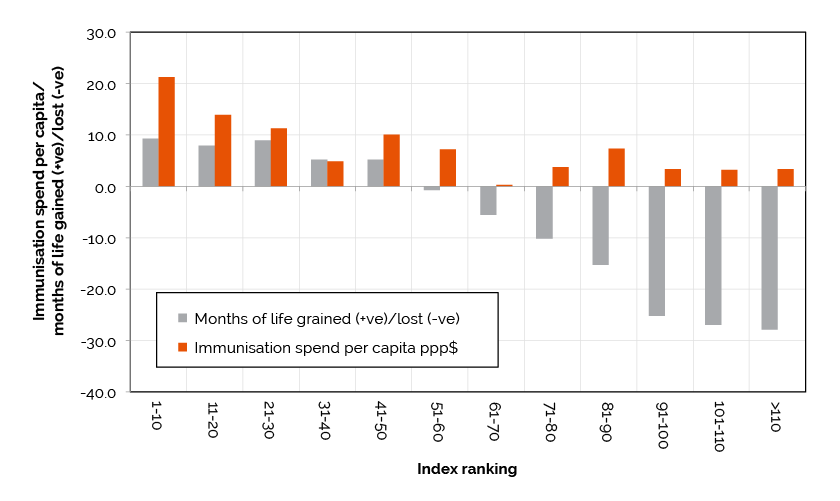
- The difference between life expectancy at birth compared with the first year or so of life is normally positive in a well performing health economy. But in less well performing countries, life expectancy at birth may be negative when compared with childhood life expectancy .
- For instance, you tend to see lower life expectancy at birth in countries with high infant mortality. This is because the high infant mortality rate has a negative effect on overall life expectancy.
- Where the difference between life expectancy at birth and 1-4 year-olds is negative, potential months of life are lost to overall life expectancy. We call this negative life expectancy. Where life expectancy is higher at birth (typically in countries with low infant mortality rates) we call this positive life expectancy.
- The chart shows wide differences using this measure. Countries that spend more per capita on immunisation not only gain more years in life expectancy but also perform better on the Index.
- This suggests that immunisation plays a critical role in improving life expectancy outcomes, leading to a higher Index ranking.
- The chart further suggests that vaccination programmes may, in general, be underfunded in around half of all counties and need to be strengthened.
Democratising access to prevention
Countries that invest in Universal Health Coverage (UHC) perform better on the Index
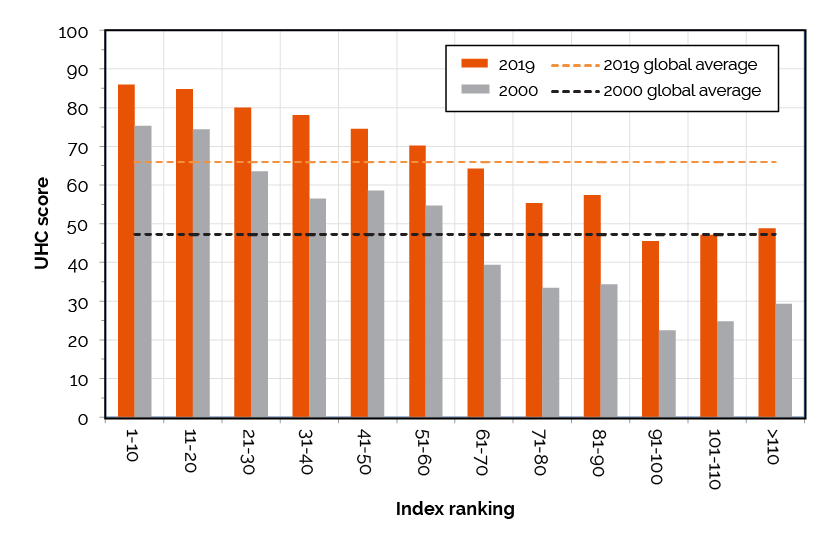
- The chart demonstrates a 40% increase in UHC coverage between 2000 and 2019, with the biggest improvements coming from lower ranked countries. This good news highlights a significant reduction in inequity of access to healthcare.
- For instance, those ranked 91-100 saw an above average increase of 102.8%. Countries ranked 101-110 saw a 90% increase in UHC, consisting mainly of African countries, but also India. Conversely, countries in the top 20, on average saw a 14.1% increase.
- Nevertheless, we still find that countries that have greater UHC coverage perform better on the Index.
Notes
About Universal Health Coverage: Universal health coverage means that all people have access to the full range of quality health services they need, when and where they need them, without financial hardship. It covers the full continuum of essential health services, from health promotion to prevention, treatment, rehabilitation and palliative care.
UHC is measured on a unitless scale of 0-100, which is computed as the geometric mean of 14 tracer indicators of health service coverage. The tracer indicators are as follows, organised by four components of service coverage: 1. Reproductive, maternal, newborn and child health 2. Infectious diseases 3. Noncommunicable diseases 4. Service capacity and access. UHC is tracked by the WHO and World Bank.
Poor diet and a lack of exercise are hampering progress

- Higher ranked countries have a greater obesity burden than lower ranked countries.
- Conversely, lower ranked countries have a greater undernourishment burden than higher ranked countries.
- Levels of obesity and undernourishment tend to be more or less equal in countries ranked between 71 and 80 on the Index.
- Unhealthy diets and poor nutrition are likely hampering progress for many countries:
- Globally, 88% of countries worldwide experience more than one form of malnutrition.
- Avoidable deaths due to poor diet have grown by 15% since 2010 and are now responsible for a quarter of all adult deaths.
Source
UNSDG
2021 Global Nutrition Report | Foreword – Global Nutrition Report
On average, countries that rank in the bottom half of the Index have four times worse access to qualified medical doctors than those that rank in the top half of the Index
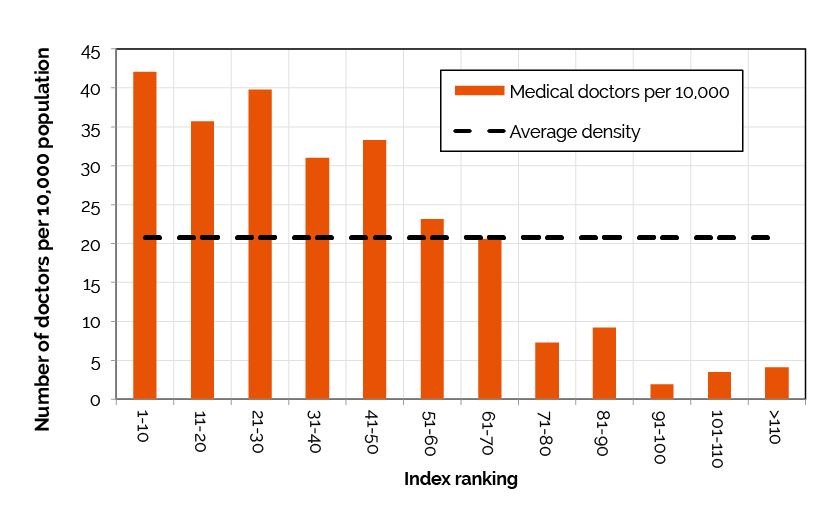
- High ranked countries have the most medical doctors with over 40 per 10,000 population. Countries ranked between 11 and 40 have around 35 per 10,000.
- Countries ranked 70 or worse fall to an average of only five per 10,000.
- According to the WHO and World Bank, at least half of the world’s population cannot obtain essential health services.
Source
UNSDG
World Bank and WHO: Half the world lacks access to essential health services, 100 million still pushed into extreme poverty because of health expenses
Non-communicable diseases (NCDs) contribute significantly to lower life expectancy

- Countries in the top 20 have comparable death rates from NCDs like heart disease and cancer but in countries ranked lower than 20, the number of deaths increase and life expectancy falls.
- It means that better ranked countries have greater access to life-saving treatment and preventative interventions that support healthier lifestyles, including access to medicines that can prolong and/or better manage chronic conditions.
- It is estimated that 80% of NCDs are preventable, mainly driven by modifiable risk factors including, tobacco use, unhealthy diet, physical inactivity, harmful use of alcohol and air pollution.
- There is a small dip in death rates from NCDs in countries with an index ranking in the range of 90-110, even though life expectancy continues to decline. A probable reason is that deaths from communicable diseases are more common and strike at younger ages, reducing exposure to NCDs in their cases.
Source
UNSDG
Sachs, J., Schmidt-Traub, G., Kroll, C., Lafortune, G., Fuller, G. (2018): SDG Index and Dashboards Report 2018.
Non Communicable Diseases | NCD Alliance
